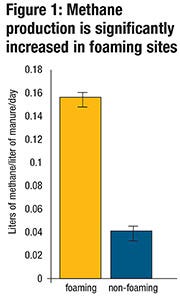2015 Research Review: Studying the causes of foaming manure
December 10, 2015

Microbial communities are significantly different between foaming and non-foaming manure storage pits. The occurrence of foam is associated with a rise in methane production and shifts in the abundance of specific bacterial species.
A multidisciplinary research team at University of Illinois at Urbana-Champaign, Iowa State University and University of Minnesota analyzed different manure samples to identify environmental and feed variables that influenced shifts in microbial communities as they relate to foaming. For each analyzed sample, the following items were classified:
Descriptive
■ Month
■ Treated status
■ Feed mill
Dietary
■ Distillers dried grain with solubles
■ Crude protein
■ Corn
■ Soybean meal
■ Salt
■ Lysine
■ Fat
■ Neutral detergent fiber 
Manure characteristics
■ Temperature
■ Sulfur
■ Foaming capacity
■ Zinc
■ Foam stability
■ Iron
■ Total nitrogen
■ Copper
■ Ammonium-N
■ pH
■ Calcium
■ Total salts
■ Sodium
■ Total solids
■ Methane production potential
The results showed that foaming samples had significantly higher pH, foaming capacity, methane production rate and lysine in comparison to non-foaming samples. In barns that transitioned to foaming status, manure was found to be higher in pH and foaming capacity along with DDGS, salt and neutral detergent fiber. A higher concentration of soybean meal, fat and crude protein was correlated with manure that transitioned to non-foaming.
Probability of foaming corresponded to significant differences in manure characteristics and feed components including pH, neutral detergent fiber and salt. Increases in these components significantly increased the odds of foaming. Crude protein was the only variable associated with decreased probability of foaming.
Furthermore, foaming and non-foaming samples differed in their microbial community composition. The bar plot shows the differences in proportion of organisms between foaming and non-foaming sites (dominant groups of organisms are indicated in the legend). The occurrence of foam is correlated with a significant increase in the relative abundance of specific bacterial species, including Ruminococcus flavefaciens. These shifts in dominant bacteria contribute to the reduction of microbial richness in foaming sites.
Methane production rate is significantly increased in foaming sites (refer to Figure 1). According to the research, DDGS and fiber were the leading feed components associated with shifts in composition of methane-producing microorganisms.
Foam in manure pits can be a danger to both animals and humans. It has been linked to the suffocation of hogs and incidents of fire and explosion. In addition, foaming manure also poses an asphyxiation risk for both people and pigs. Foaming manure can pose a serious management dilemma since there is no proven way to prevent it. Determining the cause of manure foaming can be helpful in making management decisions to reduce risk.
Researchers: Richard Gates, Laura Pepple and Angela Kent, University of Illinois-Champaign; Dan Anderson, Iowa State University; Brian Kerr and Steve Trabue, USDA-Agricultural Research Service’s National Center for Agriculture and the Environment; and Chuck Clanton, Larry Jacobson, Brian Hetchler and Bo Hu, University of Minnesota. For more information on the research, contact Angela Kent at 217-390-7740 or email [email protected].
You May Also Like



